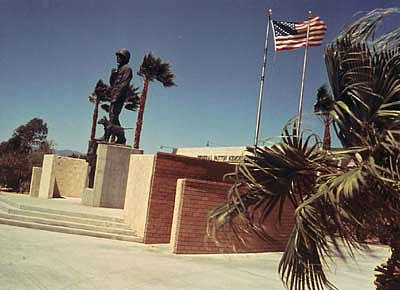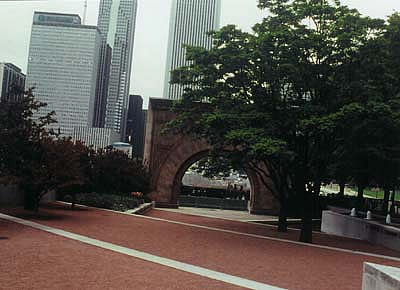 Miscellanea III
Miscellanea III
MISCELLANEA (III) shows the portal, designed by Louis H. Sullivan, to the Chicago Stock Exchange on Monroe Street in Chicago, which was erected in 1894 and torn down in 1972; ruins of a glass factory in Henryetta, Oklahoma, from which Bruce Goff bought the colorful pieces of glass he often used; a railway bridge over a creek in the desert on Highway 62; the General Patton Memorial Museum on Interstate Highway 10 and an intersection in Twentynine Palms, California; "Gateway West" - the Mexican border - and City Hall in El Paso, New Mexico; a study of downtown Oklahoma City and the national memorial designed by Hans Butzer in honor of the people killed in the bombing of the Murrah Building on April 19, 1995; the Community Center designed by William Wesley Peters in 1982 and Frank Lloyd Wright's Price Tower from 1956 in Bartlesville, Oklahoma; the Tower and geodesic Gold Dome that Robert B. Roloff built in 1958 in Oklahoma City from Buckminster Fuller's plans;the jungle gym Bruce Goff built in Bartlesville, Oklahoma in 1963 for children; a Lockheed T-33, the training version of the first twin-jet US fighter plane, built on a German model, exhibited as a sculpture in front of the Center of Commerce in Del Rio, Texas; three buildings by Frank Lloyd Wright from the 1920s, in which Bruce Goff had a hand; the oldest cement fence in Tulsa, Oklahoma, the oldest brick silo near Bartlesville, and a concrete schoolhouse from the 1920s in Dewey, Oklahoma; the burial sites of Louis H. Sullivan and Bruce Goff in Graceland Cemetery in Chicago; the warship "Puglia" built into a mountain slope on the grounds of Gabriele d'Annunzio's mausoleum, the "Vittoriale" in Gardone on Lake Garda - his body and those of ten loyal followers in sarcophagi on marble steles, high above Lake Garda. The footage from the US was taken in April and May 2002 during the filming of Goff in the Desert; the footage from the "Vittoriale" is from March 24, 1997 in preparation for the project D'Annunzio's CAVE.
Img 1: Sullivan's Arch in Chicago, USA
Img 2: Downtown Oklahoma City, USA
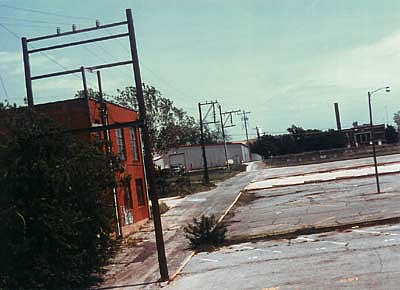 Miscellanea III
Miscellanea III
Photography and beyond (Part 10)
Country: Germany 1997-2004
Director, cinematographer, editor: Heinz Emigholz
Cooperators: Irene von Alberti, Heiner Büld, Ueli Etter, May Rigler, Frieder Schlaich, Thomas Wilk
Sound editor: Christian Obermaier
Mix: Matthias Schwab
Format: 35 mm, 1:1.37, color. Length: 22 minutes.
Abb 3: National Memorial in Oklahoma City, USA
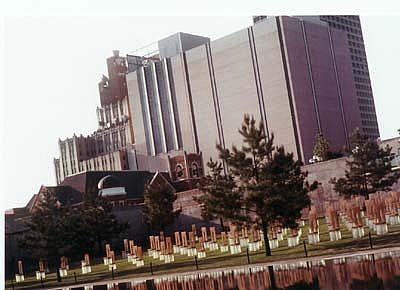 Graz, March 27, 2004. Unfortunately, and it almost seems out of defiance, people who use words professionally often insist on unexamined relations between the eye and reality: here the eye, and thus "me", there reality, what confronts me. Here the camera, also "me", there the object of my viewing. Christopher Isherwood's "I Am a Camera" has consequently been repeated with as much misunderstanding as has Louis Sullivan's "Form ever follows function". Would anyone counter-assert that he is a fountain pen or a computer, just because he cannot write? No, I "am" not a camera, and no person "is" one. The answer comes: "I Am a Camera" is only a metaphor, and the camera is an unbiased, incorruptible, perhaps a completely "dispassionate" instrument of documentation held at arm's length. Cultural researchers and curating theorists currently like it with the variant "clicking the shutter". Practiced as a business, the interpretation of the "unconscious" is somehow cheaper than composing. Much has already been written elsewhere about the impertinent equating of the eye and the camera.
Graz, March 27, 2004. Unfortunately, and it almost seems out of defiance, people who use words professionally often insist on unexamined relations between the eye and reality: here the eye, and thus "me", there reality, what confronts me. Here the camera, also "me", there the object of my viewing. Christopher Isherwood's "I Am a Camera" has consequently been repeated with as much misunderstanding as has Louis Sullivan's "Form ever follows function". Would anyone counter-assert that he is a fountain pen or a computer, just because he cannot write? No, I "am" not a camera, and no person "is" one. The answer comes: "I Am a Camera" is only a metaphor, and the camera is an unbiased, incorruptible, perhaps a completely "dispassionate" instrument of documentation held at arm's length. Cultural researchers and curating theorists currently like it with the variant "clicking the shutter". Practiced as a business, the interpretation of the "unconscious" is somehow cheaper than composing. Much has already been written elsewhere about the impertinent equating of the eye and the camera.
Abb 4: City Hall, El Paso, USA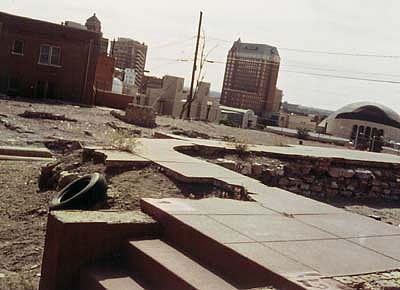 That a cinematic specialized jargon sees an authentic touch in certain shaky images (directly transmitted from the brain of one of the protagonists) and gives it the name "subjective camera" is more an indication of a manipulative set of tools. As a matter of fact, the camera is located in the space between the cinematographer and the world. So it is really two spaces: the space between the brain/eye of the photographer and the camera's field of vision (which does not consist solely of a lens, but also of an artificial "retina") and the space between this technical field of vision as a recording instrument and the arrangement of the reality that is captured. On both sides in the present interactions of this relational network, space is actively and physically made fluid.
That a cinematic specialized jargon sees an authentic touch in certain shaky images (directly transmitted from the brain of one of the protagonists) and gives it the name "subjective camera" is more an indication of a manipulative set of tools. As a matter of fact, the camera is located in the space between the cinematographer and the world. So it is really two spaces: the space between the brain/eye of the photographer and the camera's field of vision (which does not consist solely of a lens, but also of an artificial "retina") and the space between this technical field of vision as a recording instrument and the arrangement of the reality that is captured. On both sides in the present interactions of this relational network, space is actively and physically made fluid.
Abb 5: Lockheed T-33 vor dem Center of Commerce, Del Rio, USA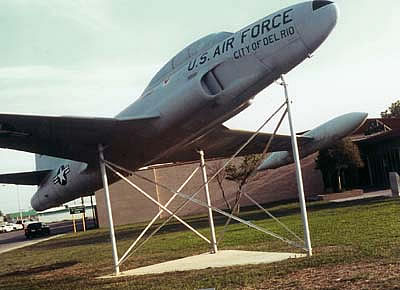 Space is melted down through the work of the gaze and, in the moment of taking the picture, welded in its components. In the act of taking the picture, a momentary linkage of spatial components is rigidified. The production of a representative image is a special case in this constellation and has little to do with thinking, if one grasps thinking as a flow. Interest should focus on the theater of the gaze, which plays out in the space between the photographer's brain and the camera's field of vision. The reality and content of the image constitute themselves in it: this is no "me", but the product of a specific process.
Space is melted down through the work of the gaze and, in the moment of taking the picture, welded in its components. In the act of taking the picture, a momentary linkage of spatial components is rigidified. The production of a representative image is a special case in this constellation and has little to do with thinking, if one grasps thinking as a flow. Interest should focus on the theater of the gaze, which plays out in the space between the photographer's brain and the camera's field of vision. The reality and content of the image constitute themselves in it: this is no "me", but the product of a specific process.
From: Heinz Emigholz: Das weiße Schamquadrat (The White Shame Square - unpublished)
Abb 6: General Patton Memorial Museum, USA
